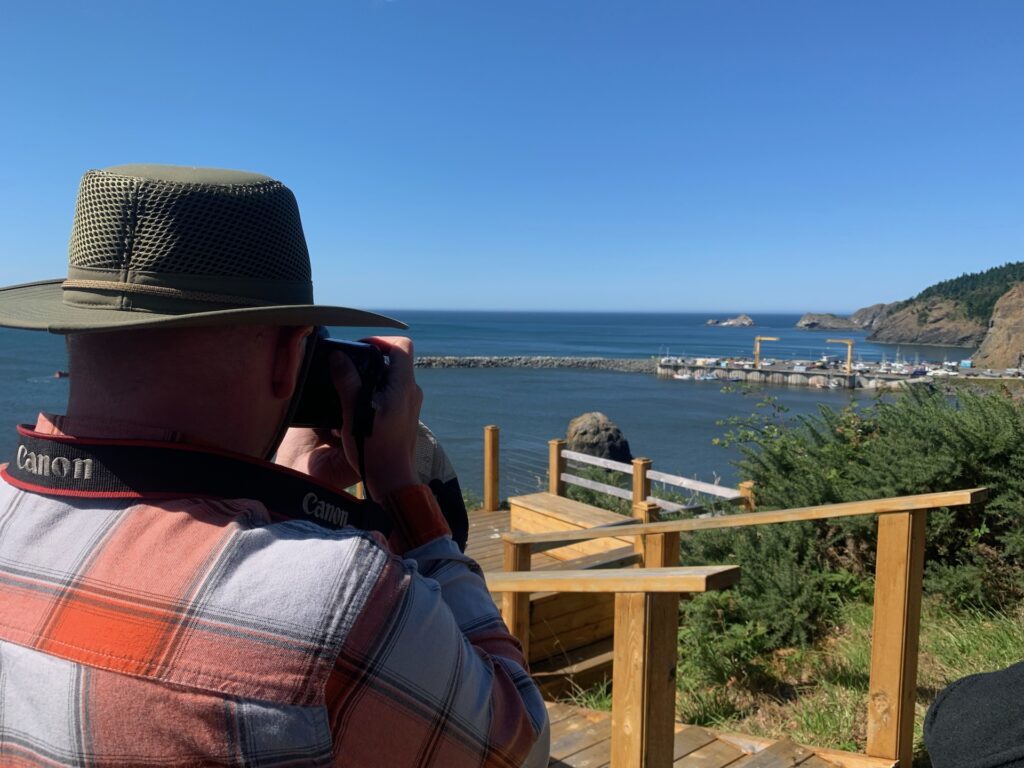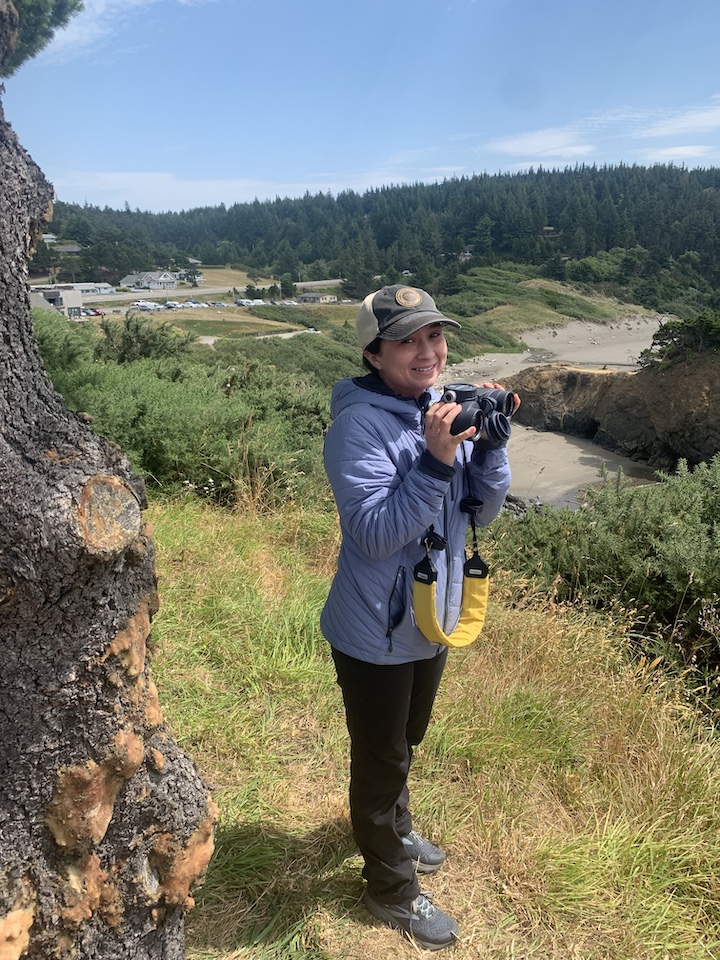By Allison Dawn, Master’s student, OSU Department of Fisheries, Wildlife and Conservation Sciences, Geospatial Ecology of Marine Megafauna Lab
Part 1: Team “Heck Yeah!”
Allison, inspecting a prey sample from the morning’s in situ collection:
“Look! It’s dungeness crab larvae.”
Damien, squinting to see the tiny megalopa floating in the water:
“Oh, heck yeah!”
This simple exchange is just a snapshot of the shared excitement the 2021 Port Orford project interns and I have felt since we have arrived at the field station. Whether it was the first time we set up the theodolite correctly, watched our first GoPro footage of the water column, or when we jumped from the dinner table to grab the camera after Lisa spotted a whale foraging in Mill Rocks – this year’s team is full of enthusiasm. Thus, I’m excited to introduce you all to the 2021 summer field team name: Team “Heck Yeah!”.
While the name is unconventional, the phrase “heck yeah” is not just an exclamation we use when excited. We also use it when we know a task will be a challenge to learn, like staying within the correct GPS position for kayak sampling stations during windy conditions. We know some tasks will be difficult, but we now say “heck yeah!” to meet challenges with a focused, positive determination. This positivity in the face of challenges is a great skill to have, especially because these first two weeks have been one steep learning curve for all of us.
If you read my previous blog, you know that I (Allison) am taking over leadership of the Port Orford project next summer. On top of learning the important day-to-day data collection tasks along with the interns, I have also been learning from Lisa how to lead this project. I am very grateful to have her here to guide me, as I have been able to witness that even when you are a seasoned project leader (this is Lisa’s 4th year!) curve balls can and do happen. It has been great to watch as she has adapted to each unexpected challenge so far, and I am learning first-hand how to best prepare for the Port Orford field season – preparation that includes expecting the unexpected.
Before I discuss in more detail the adaptations we have made and what we are seeing so far in the field, I would like to introduce the interns that comprise our JASPER program this year. Adaptability is a key skill to have when dealing with the unexpected, and after two weeks of training in abnormally windy conditions, Team “Heck Yeah!” is ready for this field season. Though it has only been two weeks, I already feel confident it will continue to be a great season and am grateful to have each one of them aboard our team.
Part 2: The 2021 Port Orford Gray Whale Foraging Ecology Team
First, I would like to introduce Jasen White. Jasen is a first generation, non-traditional undergraduate student at Oregon State University. He is a senior majoring in Fisheries and Wildlife Science and has a passion for spatial ecology and resource management. His professional management background in the U.S. Navy combined with his technical skill set has made him a great addition to the team. He has proven to be dependable and has already brought some new ideas to the project, from handling/maintaining gear to task efficiency. While we have yet to see many whales, Jasen is most looking forward to honing his theodolite skills. As we all have learned, theodolite tracking is more involved than simply looking through a scope. I appreciate the motivation he and the other interns have to become experts in each task.

The next member of our intern team is Nadia Leal. Nadia is also an undergraduate at OSU and is majoring in Marine Mammal Biology and minoring in Marine Conservation Management. She is an aspiring conservation biologist and moved all the way from Nevada to study at Oregon State University. As a previous soccer athlete in high school, teamwork and determination are two of the many skills Nadia has contributed to the Port Orford team this year. Even during the most difficult training days, her positive energy has been infectious to everyone. So far, Nadia’s favorite aspect about living at the field station is how closely she gets to interact with the community. She is fully enjoying the unique networking opportunities here – this internship has allowed her to connect with the team at Port Orford Sustainable Seafood and with other like-minded interns, such as Maddie English, a student conducting research here as part of OSU’s 2021 Marine Studies Initiative.

Last but not least is our high school intern, Damian Amerman-Smith. Damian is a rising senior at Pacific High School and plans to attend college fall 2022 to pursue a career in engineering. Due to his experience here so far, he is now considering applying to OSU! Damian is a Port Orford local and in addition to sharing his sense of humor and unique stories, he also has demonstrated curiosity, engagement, and attention to detail to every aspect of our work thus far. Damian’s favorite task at this point in the season is observing whale activity from the cliff. He picked up on nuances of the theodolite quickly and has enjoyed learning the various methods for systematic wildlife observation.

Part 3: Wind, Prey, and Looking Ahead
Now that you are familiar with the 2021 Port Orford team, it is time to discuss updates from the field! It has been particularly windy during the start of this season, and we also have had few whale encounters.
Flexibility during unfavorable weather conditions is important, and for that reason it has made the training period all that more intense. We only have two weeks to master our new skill set before we collect four weeks of standardized data, and therefore we must be sure to choose our days off wisely. Good weather days have been sparse, so we make sure they are used for field work. However, just because the forecast predicts poor conditions does not mean we immediately have the day off. Forecasts are not always accurate, and for the past week the predicted versus actual conditions were not aligned. Hence, we wake up at the usual time and often drive to the Port early to assess the weather conditions in person before deciding what is feasible that day.
Yet, with adaptability, determination, and a close eye on conditions, we have managed to persist with our kayak sampling and theodolite observations. Due to the collective persistence of Team “Heck Yeah!”, we have been able to collect exciting prey data.
It is important to note, however, that increased winds may not be ultimately bad. As Dawn has written about before on the blog, winds often increase upwelling conditions, bringing nutrients to the surface and thus increase prey abundance. In fact, we have seen an uptick in prey abundance in the past few days. In particular, we have captured increased amounts of zooplankton prey at two sampling stations in Tichenor Cove. We have seen Dungeness crab larvae, mysid swarms, and we even counted 438 amphipods that were collected in our prey net last Friday!
When I look back at the past two weeks, I am amazed to recount everything we have learned: First Aid/CPR, kayak paddle & rescue, theodolite tracking, in situ kayak prey sampling, data management, as well as gray whale and zooplankton prey ID. I know I speak for all of us when I say that these training weeks were challenging yet rewarding, and we retained our eagerness to put our new skillset to task. The future is bright as we hope to see a less wind and more whales over the next four weeks. Until then, we are saying “Heck Yeah!” to each challenge and continue to refine our skills so we are prepared when weather conditions are favorable. Stay tuned for more updates from Team “Heck Yeah!”.


Go team “heck yea”…. Proud of you!